Annemarie Friedrich
Pragmatics in the Era of Large Language Models: A Survey on Datasets, Evaluation, Opportunities and Challenges
Feb 17, 2025Abstract:Understanding pragmatics-the use of language in context-is crucial for developing NLP systems capable of interpreting nuanced language use. Despite recent advances in language technologies, including large language models, evaluating their ability to handle pragmatic phenomena such as implicatures and references remains challenging. To advance pragmatic abilities in models, it is essential to understand current evaluation trends and identify existing limitations. In this survey, we provide a comprehensive review of resources designed for evaluating pragmatic capabilities in NLP, categorizing datasets by the pragmatics phenomena they address. We analyze task designs, data collection methods, evaluation approaches, and their relevance to real-world applications. By examining these resources in the context of modern language models, we highlight emerging trends, challenges, and gaps in existing benchmarks. Our survey aims to clarify the landscape of pragmatic evaluation and guide the development of more comprehensive and targeted benchmarks, ultimately contributing to more nuanced and context-aware NLP models.
Efficient Multi-Agent Collaboration with Tool Use for Online Planning in Complex Table Question Answering
Dec 28, 2024Abstract:Complex table question answering (TQA) aims to answer questions that require complex reasoning, such as multi-step or multi-category reasoning, over data represented in tabular form. Previous approaches demonstrated notable performance by leveraging either closed-source large language models (LLMs) or fine-tuned open-weight LLMs. However, fine-tuning LLMs requires high-quality training data, which is costly to obtain, and utilizing closed-source LLMs poses accessibility challenges and leads to reproducibility issues. In this paper, we propose Multi-Agent Collaboration with Tool use (MACT), a framework that requires neither closed-source models nor fine-tuning. In MACT, a planning agent and a coding agent that also make use of tools collaborate to answer questions. Our experiments on four TQA benchmarks show that MACT outperforms previous SoTA systems on three out of four benchmarks and that it performs comparably to the larger and more expensive closed-source model GPT-4 on two benchmarks, even when using only open-weight models without any fine-tuning. We conduct extensive analyses to prove the effectiveness of MACT's multi-agent collaboration in TQA.
QUITE: Quantifying Uncertainty in Natural Language Text in Bayesian Reasoning Scenarios
Oct 14, 2024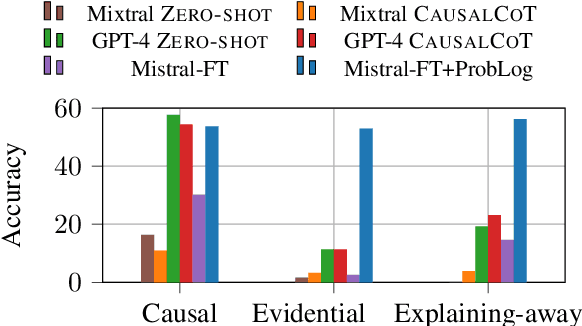
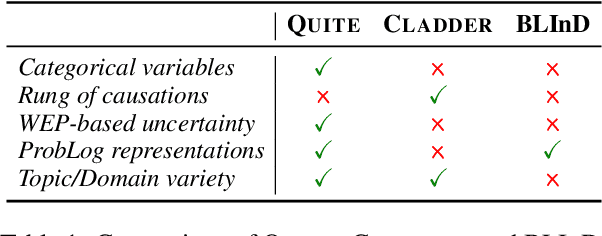
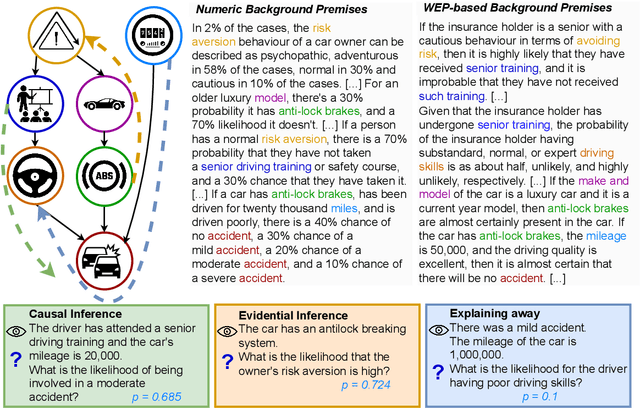
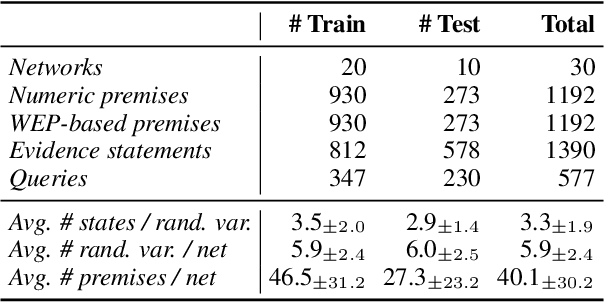
Abstract:Reasoning is key to many decision making processes. It requires consolidating a set of rule-like premises that are often associated with degrees of uncertainty and observations to draw conclusions. In this work, we address both the case where premises are specified as numeric probabilistic rules and situations in which humans state their estimates using words expressing degrees of certainty. Existing probabilistic reasoning datasets simplify the task, e.g., by requiring the model to only rank textual alternatives, by including only binary random variables, or by making use of a limited set of templates that result in less varied text. In this work, we present QUITE, a question answering dataset of real-world Bayesian reasoning scenarios with categorical random variables and complex relationships. QUITE provides high-quality natural language verbalizations of premises together with evidence statements and expects the answer to a question in the form of an estimated probability. We conduct an extensive set of experiments, finding that logic-based models outperform out-of-the-box large language models on all reasoning types (causal, evidential, and explaining-away). Our results provide evidence that neuro-symbolic models are a promising direction for improving complex reasoning. We release QUITE and code for training and experiments on Github.
Pap2Pat: Towards Automated Paper-to-Patent Drafting using Chunk-based Outline-guided Generation
Oct 09, 2024



Abstract:The patent domain is gaining attention in natural language processing research, offering practical applications in streamlining the patenting process and providing challenging benchmarks for large language models (LLMs). However, the generation of the description sections of patents, which constitute more than 90% of the patent document, has not been studied to date. We address this gap by introducing the task of outline-guided paper-to-patent generation, where an academic paper provides the technical specification of the invention and an outline conveys the desired patent structure. We present PAP2PAT, a new challenging benchmark of 1.8k patent-paper pairs with document outlines, collected using heuristics that reflect typical research lab practices. Our experiments with current open-weight LLMs and outline-guided chunk-based generation show that they can effectively use information from the paper but struggle with repetitions, likely due to the inherent repetitiveness of patent language. We release our data and code.
OMoS-QA: A Dataset for Cross-Lingual Extractive Question Answering in a German Migration Context
Jul 22, 2024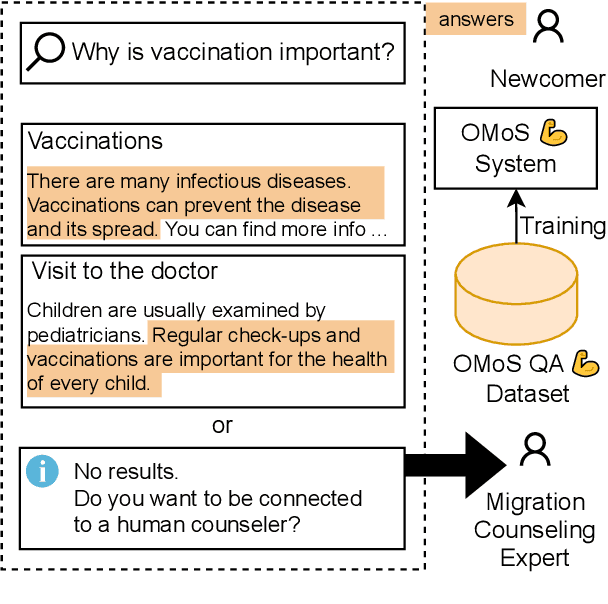
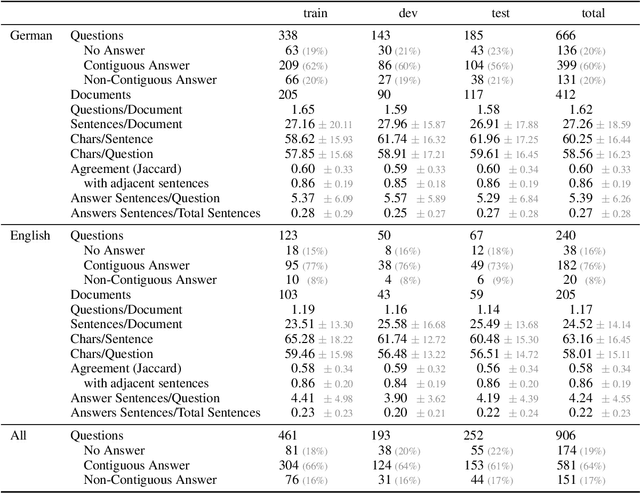
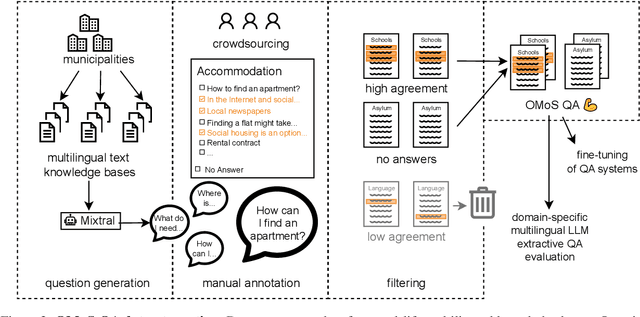
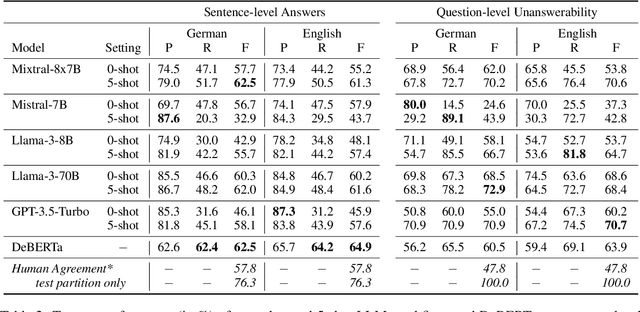
Abstract:When immigrating to a new country, it is easy to feel overwhelmed by the need to obtain information on financial support, housing, schooling, language courses, and other issues. If relocation is rushed or even forced, the necessity for high-quality answers to such questions is all the more urgent. Official immigration counselors are usually overbooked, and online systems could guide newcomers to the requested information or a suitable counseling service. To this end, we present OMoS-QA, a dataset of German and English questions paired with relevant trustworthy documents and manually annotated answers, specifically tailored to this scenario. Questions are automatically generated with an open-source large language model (LLM) and answer sentences are selected by crowd workers with high agreement. With our data, we conduct a comparison of 5 pretrained LLMs on the task of extractive question answering (QA) in German and English. Across all models and both languages, we find high precision and low-to-mid recall in selecting answer sentences, which is a favorable trade-off to avoid misleading users. This performance even holds up when the question language does not match the document language. When it comes to identifying unanswerable questions given a context, there are larger differences between the two languages.
FREB-TQA: A Fine-Grained Robustness Evaluation Benchmark for Table Question Answering
Apr 29, 2024Abstract:Table Question Answering (TQA) aims at composing an answer to a question based on tabular data. While prior research has shown that TQA models lack robustness, understanding the underlying cause and nature of this issue remains predominantly unclear, posing a significant obstacle to the development of robust TQA systems. In this paper, we formalize three major desiderata for a fine-grained evaluation of robustness of TQA systems. They should (i) answer questions regardless of alterations in table structure, (ii) base their responses on the content of relevant cells rather than on biases, and (iii) demonstrate robust numerical reasoning capabilities. To investigate these aspects, we create and publish a novel TQA evaluation benchmark in English. Our extensive experimental analysis reveals that none of the examined state-of-the-art TQA systems consistently excels in these three aspects. Our benchmark is a crucial instrument for monitoring the behavior of TQA systems and paves the way for the development of robust TQA systems. We release our benchmark publicly.
AnnoCTR: A Dataset for Detecting and Linking Entities, Tactics, and Techniques in Cyber Threat Reports
Apr 11, 2024



Abstract:Monitoring the threat landscape to be aware of actual or potential attacks is of utmost importance to cybersecurity professionals. Information about cyber threats is typically distributed using natural language reports. Natural language processing can help with managing this large amount of unstructured information, yet to date, the topic has received little attention. With this paper, we present AnnoCTR, a new CC-BY-SA-licensed dataset of cyber threat reports. The reports have been annotated by a domain expert with named entities, temporal expressions, and cybersecurity-specific concepts including implicitly mentioned techniques and tactics. Entities and concepts are linked to Wikipedia and the MITRE ATT&CK knowledge base, the most widely-used taxonomy for classifying types of attacks. Prior datasets linking to MITRE ATT&CK either provide a single label per document or annotate sentences out-of-context; our dataset annotates entire documents in a much finer-grained way. In an experimental study, we model the annotations of our dataset using state-of-the-art neural models. In our few-shot scenario, we find that for identifying the MITRE ATT&CK concepts that are mentioned explicitly or implicitly in a text, concept descriptions from MITRE ATT&CK are an effective source for training data augmentation.
BoschAI @ Causal News Corpus 2023: Robust Cause-Effect Span Extraction using Multi-Layer Sequence Tagging and Data Augmentation
Dec 11, 2023Abstract:Understanding causality is a core aspect of intelligence. The Event Causality Identification with Causal News Corpus Shared Task addresses two aspects of this challenge: Subtask 1 aims at detecting causal relationships in texts, and Subtask 2 requires identifying signal words and the spans that refer to the cause or effect, respectively. Our system, which is based on pre-trained transformers, stacked sequence tagging, and synthetic data augmentation, ranks third in Subtask 1 and wins Subtask 2 with an F1 score of 72.8, corresponding to a margin of 13 pp. to the second-best system.
BoschAI @ PLABA 2023: Leveraging Edit Operations in End-to-End Neural Sentence Simplification
Nov 03, 2023



Abstract:Automatic simplification can help laypeople to comprehend complex scientific text. Language models are frequently applied to this task by translating from complex to simple language. In this paper, we describe our system based on Llama 2, which ranked first in the PLABA shared task addressing the simplification of biomedical text. We find that the large portion of shared tokens between input and output leads to weak training signals and conservatively editing models. To mitigate these issues, we propose sentence-level and token-level loss weights. They give higher weight to modified tokens, indicated by edit distance and edit operations, respectively. We conduct an empirical evaluation on the PLABA dataset and find that both approaches lead to simplifications closer to those created by human annotators (+1.8% / +3.5% SARI), simpler language (-1 / -1.1 FKGL) and more edits (1.6x / 1.8x edit distance) compared to the same model fine-tuned with standard cross entropy. We furthermore show that the hyperparameter $\lambda$ in token-level loss weights can be used to control the edit distance and the simplicity level (FKGL).
MuLMS: A Multi-Layer Annotated Text Corpus for Information Extraction in the Materials Science Domain
Oct 24, 2023



Abstract:Keeping track of all relevant recent publications and experimental results for a research area is a challenging task. Prior work has demonstrated the efficacy of information extraction models in various scientific areas. Recently, several datasets have been released for the yet understudied materials science domain. However, these datasets focus on sub-problems such as parsing synthesis procedures or on sub-domains, e.g., solid oxide fuel cells. In this resource paper, we present MuLMS, a new dataset of 50 open-access articles, spanning seven sub-domains of materials science. The corpus has been annotated by domain experts with several layers ranging from named entities over relations to frame structures. We present competitive neural models for all tasks and demonstrate that multi-task training with existing related resources leads to benefits.
 Add to Chrome
Add to Chrome Add to Firefox
Add to Firefox Add to Edge
Add to Edge